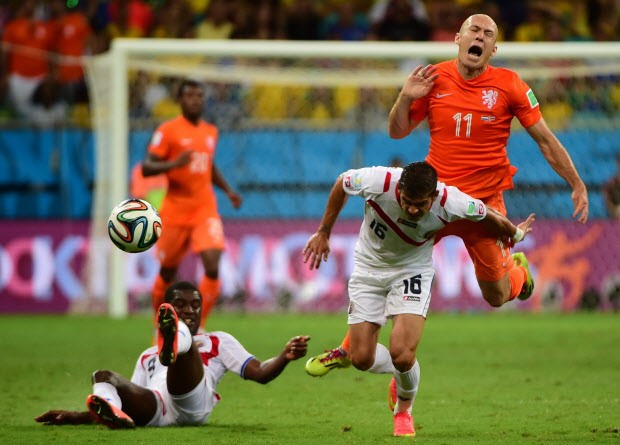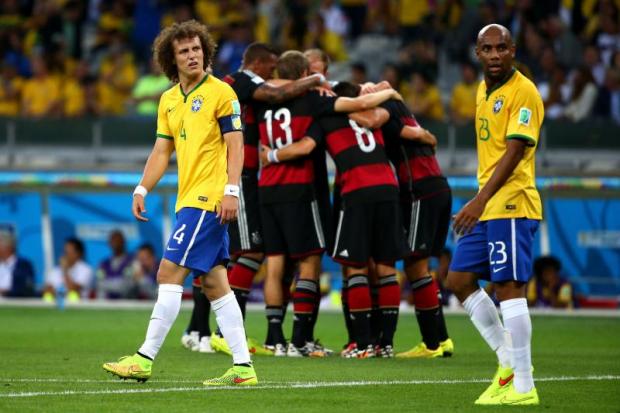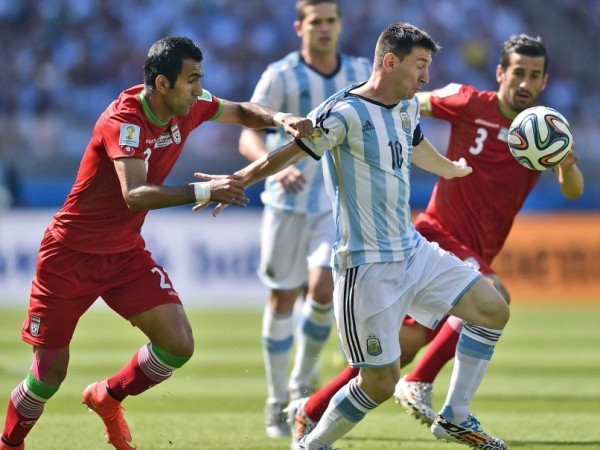Once the dust has settled on Germany’s World Cup triumph, and we have a chance to look back at one of the best spectacles in World football, we can truly realise what we witnessed this past World Cup. There were some beautiful goals, enthralling matches, intriguing tactics, controversies, dark horses and the usual stuff you get at a World Cup. But there was something wholly different about this one, the value of which we probably won’t realise until a few years later.
We’ve witnessed the defending champions of World football, embarrassed with a 5-1 scoreline and knocked out early of the competition. The hosts, the traditional power house of the sport, one of the favourites for the 2014 edition completely humiliated in their own back yard. Earlier on in the competition, to a somewhat lesser degree, there was also a quite heavy defeat for the Portuguese, losing their first game 4-0.
While these big teams have rolled over in crucial matches, and stronger teams like England/Italy have crashed out in the group stage, we’ve seen the lesser known sides actually put up a better show.
Costa Rica are the obvious nominee in this category having shocked the World with their run at the tournament. If topping the group of death wasn’t an achievement enough, they nearly got till the semi-finals, losing out on penalties. Algeria too were a side that impressed and were arguably the only team that looked adept at beating Germany (as did Ghana to a certain extent).
Mexico impressively held Brazil and were moments away from going past Netherlands too. Iran were a side that managed to keep Lionel Messi quiet better than any other opponents did. Switzerland & Belgium both struggled while even the winners Germany were coming under constant pressure from the Barcelona star.
So how did it happen that the big teams, with the big stars playing at the big clubs with all the resources at their disposal, quality experienced managers and big pay checks for incentives, fail to perform better than those who are less fortunate? Many of the aforementioned smaller teams have players playing in clubs in North American obscurity, small sides in the Middle East and the ‘not-so-big’ clubs of Europe. These clubs don’t have the resources you’d find in Madrid & Manchester. They aren’t as tactically well versed, neither are their club managers. The head coaches of the national teams too, though experienced, have come no where close to the biggest stage of football in their careers.
How then does a team like Costa Rica land up a penalty kick away from the semi-final while Spain returned home in June? How did Algeria play such impressive football while their opponents in a drab match four years back, England, come away with nothing more than 2 goals and 1 point?
The reason for these can range from tactics so psychology, from weather to misfortune. That is a question that can be answered on another day. But the success of those smaller teams gives us some key tactical takeaways from this World Cup.
Use full-backs wisely
The first factor that influenced such results is the basic set-up. If you look at the teams like Costa Rica & Mexico. Their emphasis and reliance was on their back line. While many will clamor on about how good Joel Campbell, Bryan Ruiz and Oribe Peralta were, the fact remains that Costa Rica & Mexico’s success was purely down to their defensive players (and ofcourse some incredible goalkeeping).
The key men and standout performers for both Costa Rica and Mexico were their full-backs. Cristian Gamboa & Junior Diaz played on either side of a five-man defence for Costa Rica, while Paul Aguilar & Miguel Layun were the impressive men for Miguel Herrera. The work rate of these four players throughout the World Cup was incredibly immense. They were the key men because both Costa Rica & Mexico played a 3-5-2 system, or a 5-3-2 one; the crucial point in that statement is that the formation played was defined by the role of the full-backs. The coaches could either give them more attacking freedom or ensure a more rigid defensive system, the former would work as a 3-5-2 and the latter as a 5-3-2. The transition of play from getting the ball from a defensive phase into attack and falling back into defense from an attacking phase was done purely by the work of these full-backs. The role of the remaining players in the side remained almost identical irrespective of the formation employed or the phase of play.
So when Mexico came up against a superior Brazilian side, these full-back stuck deep and formed a five man defensive line, Brazil thus struggled to break them down as their defensive ability was matching that of their centre-backs stride for stride. But when up against a rather equal side in Croatia & Cameroon, these full-back were seen constantly making darting runs from the back and providing in support, creating opportunities for their attackers. The burden of defence in this system ofcourse fell on the three men at the back but the work-rate of these full-backs allowed them to contribute equally in both extremes.
Costa Rica’s full-backs followed a similar system as the Mexicans did. But their rather inexperience at the highest level turned out to work in their favour. The usual thing with smaller teams is that when they play the bigger sides they naturally fall into a more defensive approach and look to contain the superior side, hitting them with counters. But these inexperienced full-backs of Costa Rica didn’t have that same defensive intelligence, they were willing to get forward more often than the system required. So while they were solid in defence against the likes of Uruguay & Italy, Gamboa & Diaz’ constant urge to attack caught the opposition by surprise. Rather than just defending against the big teams like Mexico did, they took the game to the opposition.
So Mexico showed us how to use the full-backs defensively, Costa Rica probably showed us the perfect way of using them with a right balance between defence & attack.
Attack the best form of defence
This adventurous system of Costa Rica is something noticeable with Algeria as well. The highest placed African side in the competition were also arguably the most attacking one. This was most notable against Germany who were constantly threatened by the wave of Algerian attacks. We saw teams like USA, France struggle to break the Germans down because they approached the game with the thinking that they first needed to contain the German attack. Algeria realised that though they impressed defensively against Russia, the only chance they had against this German side was an attacking one. They thus, rather naively, kept up constant attacks against the European giants which worked in their favour. Partly because the Germans didn’t expect such an attack, and partly because their full-backs were awful on the night.
This regular attacking flow from Valid Halihadzovic’s men proved to be the most difficult system the Germans played against. The eventual World Cup winners favour a system that requires play to be created from the back with direct passing; you won’t often see the calm Germans forced into hopeful balls. Algeria showed the World how to beat that system. Rather than a pragmatic system of defending against the big teams, Algeria showed how an attacking approach can actually be the more beneficial system.
It has to be said that Mexico & Costa Rica’s full-back approach might have been equally successful against Germany, but Algeria showed a whole different side of approaching the big games. Attacking with a “nothing to lose” attitude isn’t something new in the beautiful game, but Algeria’s success gives a lesson to even the bigger sides not to be as cautious as they have. England & Italy could probably have been more successful had they been more attacking than they were.
Zonal mark the key man rather than man mark
As we mentioned earlier, the system Iran employed to contain Messi was the most successful one despite his late goal. Argentina’s subsequent European opponents failed to contain the star as much as the minnows Iran did. Again, the most telling factor was the reliance on defence. Lionel Messi, like many footballers, loves to work with space. Iran realising this, cut out any space in attack and rather than putting one man on Messi (like the Swiss and Belgium attempted to), the Asians employed a zonal marking system on the Barcelona playmaker. It resulted in Messi completely outwitted and lacking in any real influence until that late goal.
The zonal marking system employed by Iran meant that wherever Lionel Messi moved, he had two men in and around him and a third that marked out his passing option. So Messi didn’t have a player to pass to, neither did he have the time & space to do something on his own.
The usual system teams employ against Messi, which Netherlands did successfully, was deploying one solid defensive player to constantly contain the playmaker. This system requires a player who is capable of playing the role up to the mark, which Nigel De Jong was (and is one of the best in the World at that role). But not every side has the liberty of having a player in the De Jong mould and often make a failed attempt at employing the system. Iran thus showed the perfect method at containing a play-maker, though not new but emphasising again it’s effectiveness (off the top of my head Chelsea had done the same with Luis Suarez in their game at Stamford Bridge last season).
So while there is a lot we can learn from the big sides and the household names, teams like Mexico, Costa Rica, Iran & Algeria have given us key takeaways from this World Cup. While Algeria’s lesson isn’t new, Iran’s can hopefully see sides employ this successful system against playmakers. But Mexico & Costa Rica’s 3-5-2/5-3-2 has been the most important tactical takeaway in the competition, one that we can hopefully see more often.
This article was written by Sami Faizullah. Editor-in-chief of outsideoftheboot.com. Follow the website on Twitter @OOTB_football
Add Sportslens to your Google News Feed!



